Chinese Medicine and Menopause: Traditional Treatments and Symptoms
VerifiedAdded on 2020/05/11
|9
|2760
|145
Essay
AI Summary
This essay delves into the application of Traditional Chinese Medicine (TCM) in managing menopause symptoms. It begins by defining menopause and its associated symptoms, including hot flushes, mood changes, and potential health risks. The essay then explores various TCM treatments, such as herbal medication, acupuncture, moxibustion, and cupping, detailing their mechanisms and efficacy. It discusses the use of herbal products like phytoestrogens, ginseng, and St. John's wort, citing studies on their impact on menopausal symptoms. The essay also examines acupuncture's role in alleviating hot flushes and other symptoms, while acknowledging potential complications. Furthermore, it investigates the use of moxibustion and cupping, highlighting their effects on hot flushes and other conditions. The essay references multiple studies and research papers to support its claims, providing a comprehensive overview of TCM's approach to menopause and its potential benefits and limitations. The essay also touches upon the ethical considerations of placebo effects in traditional medicine, and concludes by summarizing the various treatment methods and their effectiveness.
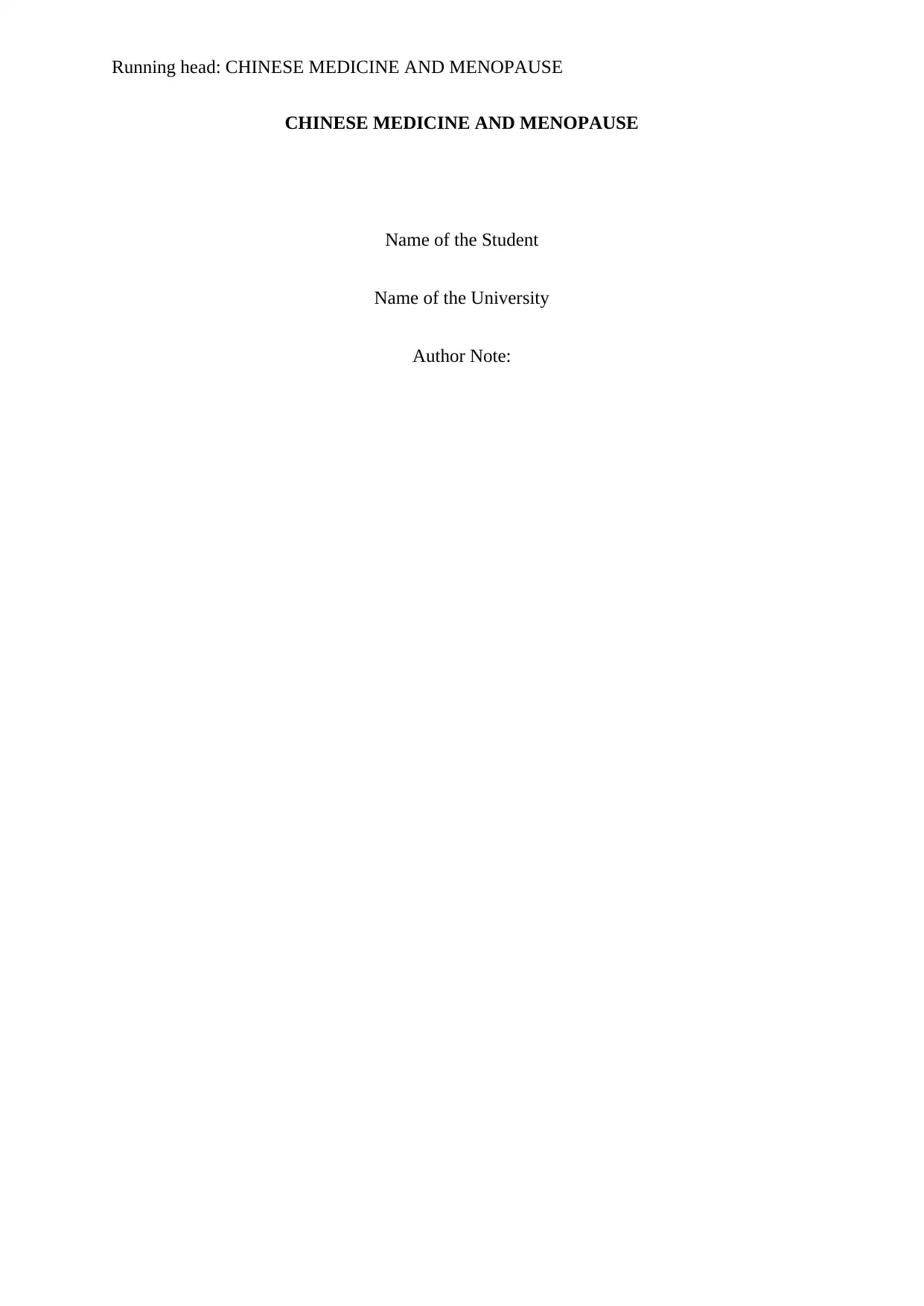
Running head: CHINESE MEDICINE AND MENOPAUSE
CHINESE MEDICINE AND MENOPAUSE
Name of the Student
Name of the University
Author Note:
CHINESE MEDICINE AND MENOPAUSE
Name of the Student
Name of the University
Author Note:
Paraphrase This Document
Need a fresh take? Get an instant paraphrase of this document with our AI Paraphraser
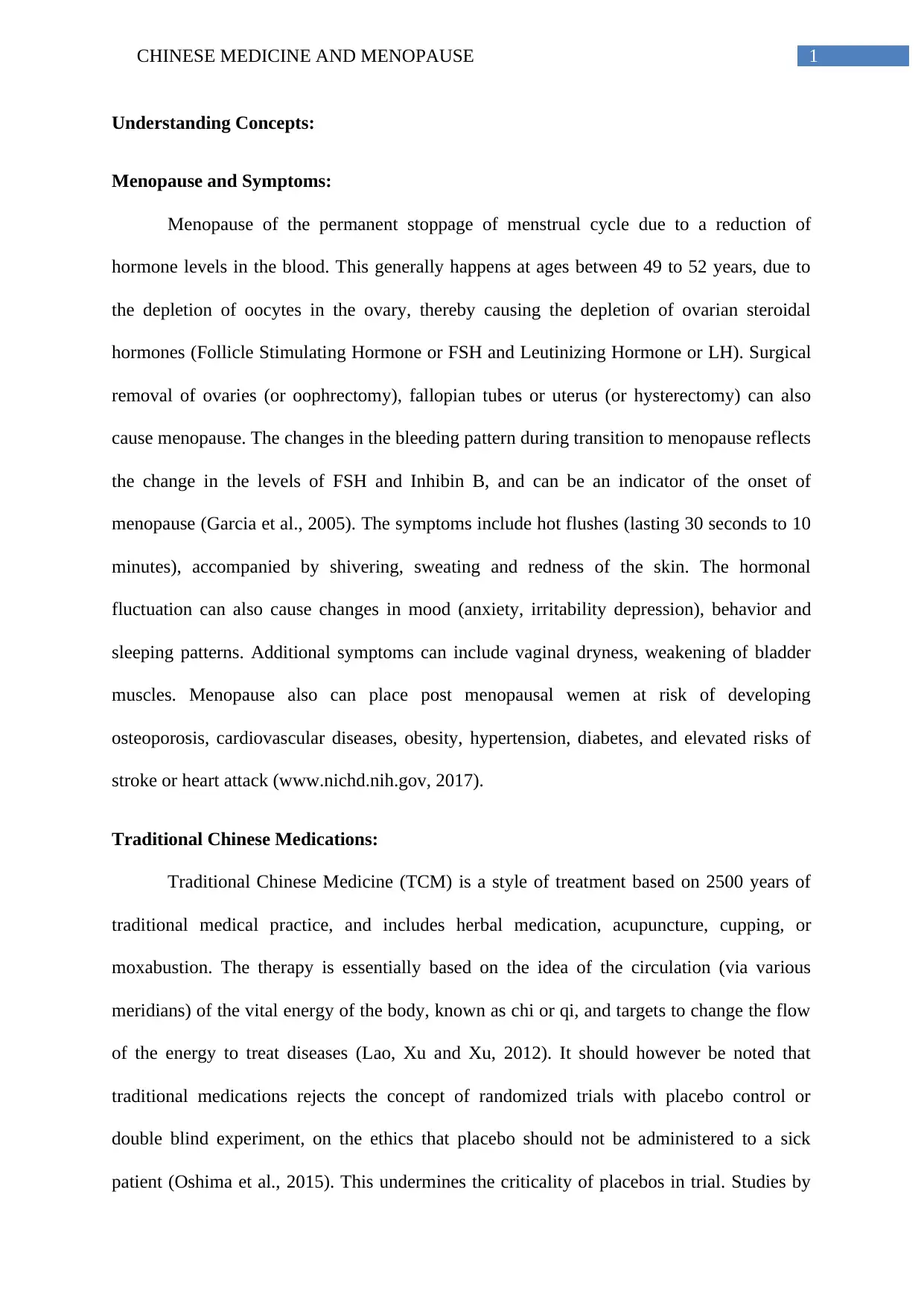
1CHINESE MEDICINE AND MENOPAUSE
Understanding Concepts:
Menopause and Symptoms:
Menopause of the permanent stoppage of menstrual cycle due to a reduction of
hormone levels in the blood. This generally happens at ages between 49 to 52 years, due to
the depletion of oocytes in the ovary, thereby causing the depletion of ovarian steroidal
hormones (Follicle Stimulating Hormone or FSH and Leutinizing Hormone or LH). Surgical
removal of ovaries (or oophrectomy), fallopian tubes or uterus (or hysterectomy) can also
cause menopause. The changes in the bleeding pattern during transition to menopause reflects
the change in the levels of FSH and Inhibin B, and can be an indicator of the onset of
menopause (Garcia et al., 2005). The symptoms include hot flushes (lasting 30 seconds to 10
minutes), accompanied by shivering, sweating and redness of the skin. The hormonal
fluctuation can also cause changes in mood (anxiety, irritability depression), behavior and
sleeping patterns. Additional symptoms can include vaginal dryness, weakening of bladder
muscles. Menopause also can place post menopausal wemen at risk of developing
osteoporosis, cardiovascular diseases, obesity, hypertension, diabetes, and elevated risks of
stroke or heart attack (www.nichd.nih.gov, 2017).
Traditional Chinese Medications:
Traditional Chinese Medicine (TCM) is a style of treatment based on 2500 years of
traditional medical practice, and includes herbal medication, acupuncture, cupping, or
moxabustion. The therapy is essentially based on the idea of the circulation (via various
meridians) of the vital energy of the body, known as chi or qi, and targets to change the flow
of the energy to treat diseases (Lao, Xu and Xu, 2012). It should however be noted that
traditional medications rejects the concept of randomized trials with placebo control or
double blind experiment, on the ethics that placebo should not be administered to a sick
patient (Oshima et al., 2015). This undermines the criticality of placebos in trial. Studies by
Understanding Concepts:
Menopause and Symptoms:
Menopause of the permanent stoppage of menstrual cycle due to a reduction of
hormone levels in the blood. This generally happens at ages between 49 to 52 years, due to
the depletion of oocytes in the ovary, thereby causing the depletion of ovarian steroidal
hormones (Follicle Stimulating Hormone or FSH and Leutinizing Hormone or LH). Surgical
removal of ovaries (or oophrectomy), fallopian tubes or uterus (or hysterectomy) can also
cause menopause. The changes in the bleeding pattern during transition to menopause reflects
the change in the levels of FSH and Inhibin B, and can be an indicator of the onset of
menopause (Garcia et al., 2005). The symptoms include hot flushes (lasting 30 seconds to 10
minutes), accompanied by shivering, sweating and redness of the skin. The hormonal
fluctuation can also cause changes in mood (anxiety, irritability depression), behavior and
sleeping patterns. Additional symptoms can include vaginal dryness, weakening of bladder
muscles. Menopause also can place post menopausal wemen at risk of developing
osteoporosis, cardiovascular diseases, obesity, hypertension, diabetes, and elevated risks of
stroke or heart attack (www.nichd.nih.gov, 2017).
Traditional Chinese Medications:
Traditional Chinese Medicine (TCM) is a style of treatment based on 2500 years of
traditional medical practice, and includes herbal medication, acupuncture, cupping, or
moxabustion. The therapy is essentially based on the idea of the circulation (via various
meridians) of the vital energy of the body, known as chi or qi, and targets to change the flow
of the energy to treat diseases (Lao, Xu and Xu, 2012). It should however be noted that
traditional medications rejects the concept of randomized trials with placebo control or
double blind experiment, on the ethics that placebo should not be administered to a sick
patient (Oshima et al., 2015). This undermines the criticality of placebos in trial. Studies by
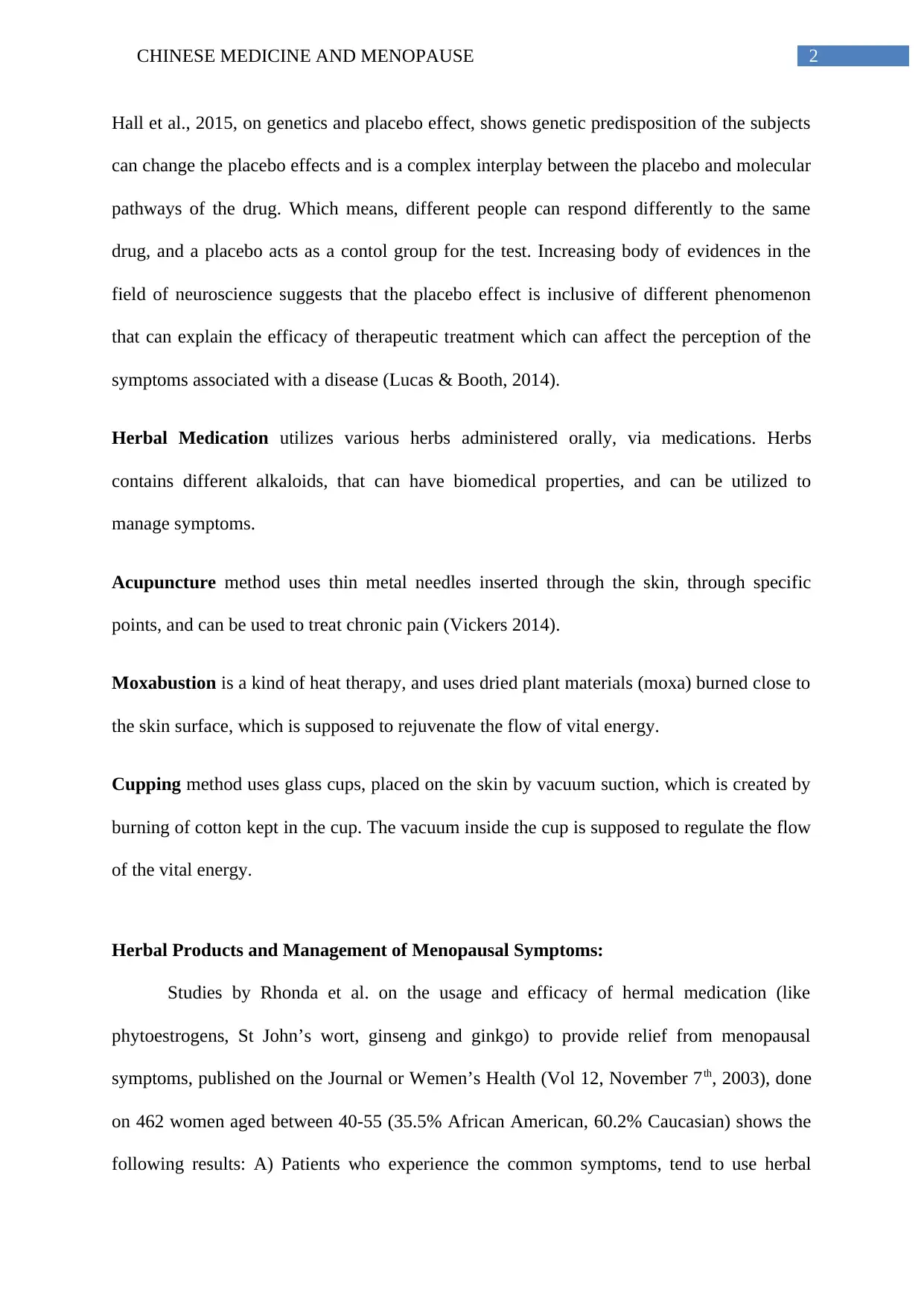
2CHINESE MEDICINE AND MENOPAUSE
Hall et al., 2015, on genetics and placebo effect, shows genetic predisposition of the subjects
can change the placebo effects and is a complex interplay between the placebo and molecular
pathways of the drug. Which means, different people can respond differently to the same
drug, and a placebo acts as a contol group for the test. Increasing body of evidences in the
field of neuroscience suggests that the placebo effect is inclusive of different phenomenon
that can explain the efficacy of therapeutic treatment which can affect the perception of the
symptoms associated with a disease (Lucas & Booth, 2014).
Herbal Medication utilizes various herbs administered orally, via medications. Herbs
contains different alkaloids, that can have biomedical properties, and can be utilized to
manage symptoms.
Acupuncture method uses thin metal needles inserted through the skin, through specific
points, and can be used to treat chronic pain (Vickers 2014).
Moxabustion is a kind of heat therapy, and uses dried plant materials (moxa) burned close to
the skin surface, which is supposed to rejuvenate the flow of vital energy.
Cupping method uses glass cups, placed on the skin by vacuum suction, which is created by
burning of cotton kept in the cup. The vacuum inside the cup is supposed to regulate the flow
of the vital energy.
Herbal Products and Management of Menopausal Symptoms:
Studies by Rhonda et al. on the usage and efficacy of hermal medication (like
phytoestrogens, St John’s wort, ginseng and ginkgo) to provide relief from menopausal
symptoms, published on the Journal or Wemen’s Health (Vol 12, November 7th, 2003), done
on 462 women aged between 40-55 (35.5% African American, 60.2% Caucasian) shows the
following results: A) Patients who experience the common symptoms, tend to use herbal
Hall et al., 2015, on genetics and placebo effect, shows genetic predisposition of the subjects
can change the placebo effects and is a complex interplay between the placebo and molecular
pathways of the drug. Which means, different people can respond differently to the same
drug, and a placebo acts as a contol group for the test. Increasing body of evidences in the
field of neuroscience suggests that the placebo effect is inclusive of different phenomenon
that can explain the efficacy of therapeutic treatment which can affect the perception of the
symptoms associated with a disease (Lucas & Booth, 2014).
Herbal Medication utilizes various herbs administered orally, via medications. Herbs
contains different alkaloids, that can have biomedical properties, and can be utilized to
manage symptoms.
Acupuncture method uses thin metal needles inserted through the skin, through specific
points, and can be used to treat chronic pain (Vickers 2014).
Moxabustion is a kind of heat therapy, and uses dried plant materials (moxa) burned close to
the skin surface, which is supposed to rejuvenate the flow of vital energy.
Cupping method uses glass cups, placed on the skin by vacuum suction, which is created by
burning of cotton kept in the cup. The vacuum inside the cup is supposed to regulate the flow
of the vital energy.
Herbal Products and Management of Menopausal Symptoms:
Studies by Rhonda et al. on the usage and efficacy of hermal medication (like
phytoestrogens, St John’s wort, ginseng and ginkgo) to provide relief from menopausal
symptoms, published on the Journal or Wemen’s Health (Vol 12, November 7th, 2003), done
on 462 women aged between 40-55 (35.5% African American, 60.2% Caucasian) shows the
following results: A) Patients who experience the common symptoms, tend to use herbal
⊘ This is a preview!⊘
Do you want full access?
Subscribe today to unlock all pages.

Trusted by 1+ million students worldwide
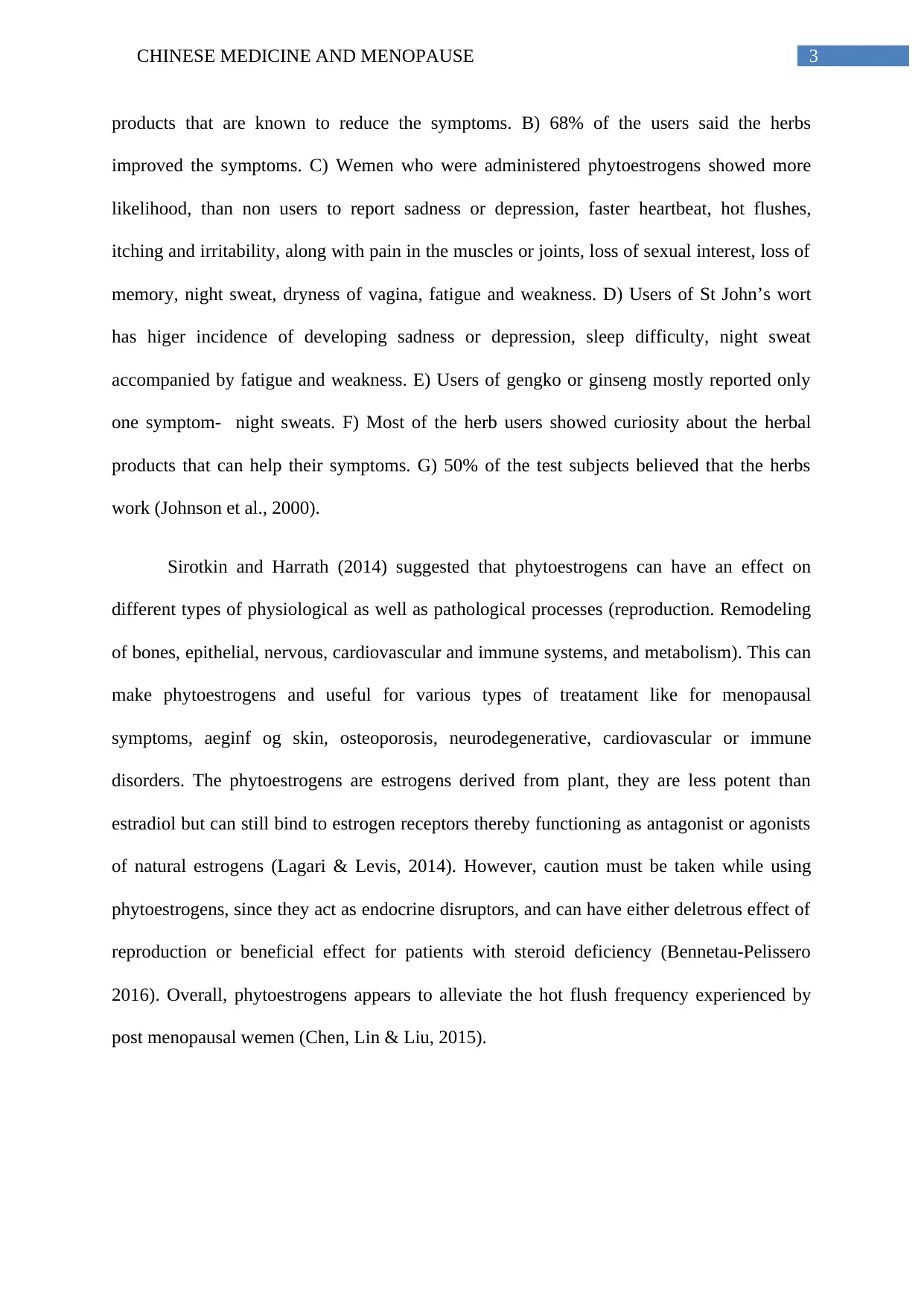
3CHINESE MEDICINE AND MENOPAUSE
products that are known to reduce the symptoms. B) 68% of the users said the herbs
improved the symptoms. C) Wemen who were administered phytoestrogens showed more
likelihood, than non users to report sadness or depression, faster heartbeat, hot flushes,
itching and irritability, along with pain in the muscles or joints, loss of sexual interest, loss of
memory, night sweat, dryness of vagina, fatigue and weakness. D) Users of St John’s wort
has higer incidence of developing sadness or depression, sleep difficulty, night sweat
accompanied by fatigue and weakness. E) Users of gengko or ginseng mostly reported only
one symptom- night sweats. F) Most of the herb users showed curiosity about the herbal
products that can help their symptoms. G) 50% of the test subjects believed that the herbs
work (Johnson et al., 2000).
Sirotkin and Harrath (2014) suggested that phytoestrogens can have an effect on
different types of physiological as well as pathological processes (reproduction. Remodeling
of bones, epithelial, nervous, cardiovascular and immune systems, and metabolism). This can
make phytoestrogens and useful for various types of treatament like for menopausal
symptoms, aeginf og skin, osteoporosis, neurodegenerative, cardiovascular or immune
disorders. The phytoestrogens are estrogens derived from plant, they are less potent than
estradiol but can still bind to estrogen receptors thereby functioning as antagonist or agonists
of natural estrogens (Lagari & Levis, 2014). However, caution must be taken while using
phytoestrogens, since they act as endocrine disruptors, and can have either deletrous effect of
reproduction or beneficial effect for patients with steroid deficiency (Bennetau-Pelissero
2016). Overall, phytoestrogens appears to alleviate the hot flush frequency experienced by
post menopausal wemen (Chen, Lin & Liu, 2015).
products that are known to reduce the symptoms. B) 68% of the users said the herbs
improved the symptoms. C) Wemen who were administered phytoestrogens showed more
likelihood, than non users to report sadness or depression, faster heartbeat, hot flushes,
itching and irritability, along with pain in the muscles or joints, loss of sexual interest, loss of
memory, night sweat, dryness of vagina, fatigue and weakness. D) Users of St John’s wort
has higer incidence of developing sadness or depression, sleep difficulty, night sweat
accompanied by fatigue and weakness. E) Users of gengko or ginseng mostly reported only
one symptom- night sweats. F) Most of the herb users showed curiosity about the herbal
products that can help their symptoms. G) 50% of the test subjects believed that the herbs
work (Johnson et al., 2000).
Sirotkin and Harrath (2014) suggested that phytoestrogens can have an effect on
different types of physiological as well as pathological processes (reproduction. Remodeling
of bones, epithelial, nervous, cardiovascular and immune systems, and metabolism). This can
make phytoestrogens and useful for various types of treatament like for menopausal
symptoms, aeginf og skin, osteoporosis, neurodegenerative, cardiovascular or immune
disorders. The phytoestrogens are estrogens derived from plant, they are less potent than
estradiol but can still bind to estrogen receptors thereby functioning as antagonist or agonists
of natural estrogens (Lagari & Levis, 2014). However, caution must be taken while using
phytoestrogens, since they act as endocrine disruptors, and can have either deletrous effect of
reproduction or beneficial effect for patients with steroid deficiency (Bennetau-Pelissero
2016). Overall, phytoestrogens appears to alleviate the hot flush frequency experienced by
post menopausal wemen (Chen, Lin & Liu, 2015).
Paraphrase This Document
Need a fresh take? Get an instant paraphrase of this document with our AI Paraphraser
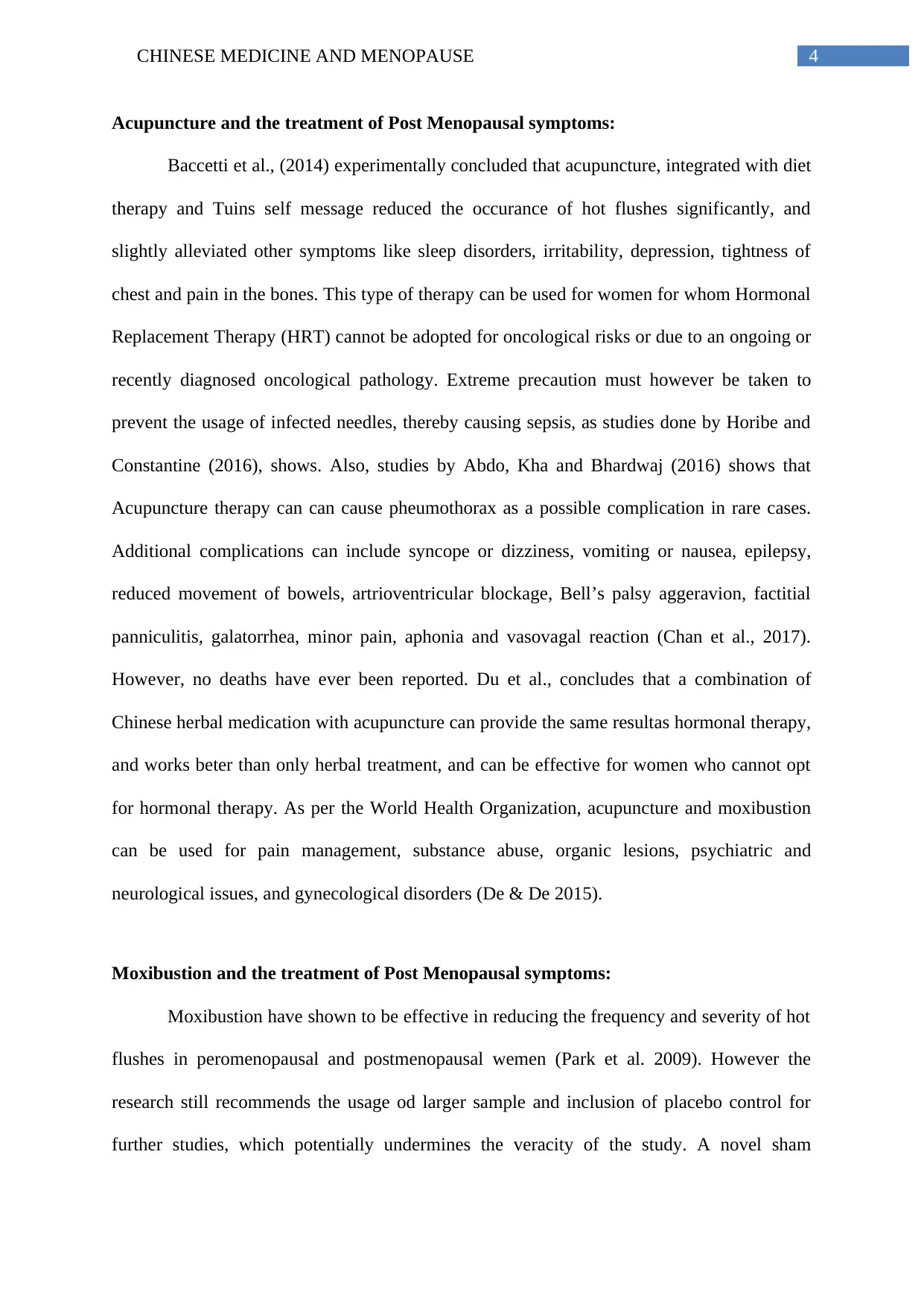
4CHINESE MEDICINE AND MENOPAUSE
Acupuncture and the treatment of Post Menopausal symptoms:
Baccetti et al., (2014) experimentally concluded that acupuncture, integrated with diet
therapy and Tuins self message reduced the occurance of hot flushes significantly, and
slightly alleviated other symptoms like sleep disorders, irritability, depression, tightness of
chest and pain in the bones. This type of therapy can be used for women for whom Hormonal
Replacement Therapy (HRT) cannot be adopted for oncological risks or due to an ongoing or
recently diagnosed oncological pathology. Extreme precaution must however be taken to
prevent the usage of infected needles, thereby causing sepsis, as studies done by Horibe and
Constantine (2016), shows. Also, studies by Abdo, Kha and Bhardwaj (2016) shows that
Acupuncture therapy can can cause pheumothorax as a possible complication in rare cases.
Additional complications can include syncope or dizziness, vomiting or nausea, epilepsy,
reduced movement of bowels, artrioventricular blockage, Bell’s palsy aggeravion, factitial
panniculitis, galatorrhea, minor pain, aphonia and vasovagal reaction (Chan et al., 2017).
However, no deaths have ever been reported. Du et al., concludes that a combination of
Chinese herbal medication with acupuncture can provide the same resultas hormonal therapy,
and works beter than only herbal treatment, and can be effective for women who cannot opt
for hormonal therapy. As per the World Health Organization, acupuncture and moxibustion
can be used for pain management, substance abuse, organic lesions, psychiatric and
neurological issues, and gynecological disorders (De & De 2015).
Moxibustion and the treatment of Post Menopausal symptoms:
Moxibustion have shown to be effective in reducing the frequency and severity of hot
flushes in peromenopausal and postmenopausal wemen (Park et al. 2009). However the
research still recommends the usage od larger sample and inclusion of placebo control for
further studies, which potentially undermines the veracity of the study. A novel sham
Acupuncture and the treatment of Post Menopausal symptoms:
Baccetti et al., (2014) experimentally concluded that acupuncture, integrated with diet
therapy and Tuins self message reduced the occurance of hot flushes significantly, and
slightly alleviated other symptoms like sleep disorders, irritability, depression, tightness of
chest and pain in the bones. This type of therapy can be used for women for whom Hormonal
Replacement Therapy (HRT) cannot be adopted for oncological risks or due to an ongoing or
recently diagnosed oncological pathology. Extreme precaution must however be taken to
prevent the usage of infected needles, thereby causing sepsis, as studies done by Horibe and
Constantine (2016), shows. Also, studies by Abdo, Kha and Bhardwaj (2016) shows that
Acupuncture therapy can can cause pheumothorax as a possible complication in rare cases.
Additional complications can include syncope or dizziness, vomiting or nausea, epilepsy,
reduced movement of bowels, artrioventricular blockage, Bell’s palsy aggeravion, factitial
panniculitis, galatorrhea, minor pain, aphonia and vasovagal reaction (Chan et al., 2017).
However, no deaths have ever been reported. Du et al., concludes that a combination of
Chinese herbal medication with acupuncture can provide the same resultas hormonal therapy,
and works beter than only herbal treatment, and can be effective for women who cannot opt
for hormonal therapy. As per the World Health Organization, acupuncture and moxibustion
can be used for pain management, substance abuse, organic lesions, psychiatric and
neurological issues, and gynecological disorders (De & De 2015).
Moxibustion and the treatment of Post Menopausal symptoms:
Moxibustion have shown to be effective in reducing the frequency and severity of hot
flushes in peromenopausal and postmenopausal wemen (Park et al. 2009). However the
research still recommends the usage od larger sample and inclusion of placebo control for
further studies, which potentially undermines the veracity of the study. A novel sham

5CHINESE MEDICINE AND MENOPAUSE
moxibustion pillars can be used to provide placebo-control in moxibustion research, thereby
fulfilling the need for the double blind protocol (Zhao et al., 2006). This treatment can also
provide positive results for treating primary osteoporosis (POP), however the efficacy could
not be concluded definitely (Xu et al., 2017). Sudies have also shown that Moxibustion used
with Electroacupuncture can be used to treat psychiatric conditions, as they can have an
antidepressive action by the regulation of HPA axis as well as affect the hippocampus and
influence the dipaminergic and serotonergic systems of the body (Kim et al., 2017).
Cupping and the treatment of Post Menopausal symptoms:
The earliest records for the usage of cupping dates back to the Greek historian
Herodotus (400 BC), used for the treatment of headaches, appetite loss, digestion problems,
fainting, narcolepsy, and abcesses. Dry and wet cupping techniques were commonly
practiced using cups of glass, horn or brass (Mehta & Dhapte, 2015). Adverse effects of
cupping were reported in studies, but have been shown to be rare, and emphasizes the
treatment be administered by only medical experts, and be compliant of the guidelines for
safety (Kim et al., 2014). Also, a control of the negative pressure produced inside the cups
can prevent negative effects like dermatitis bullae (Peng, How & Bullae, 2013). Cupping can
also decrease the ODI and VAS scores for LBP patients (Wang et al., 2017).
moxibustion pillars can be used to provide placebo-control in moxibustion research, thereby
fulfilling the need for the double blind protocol (Zhao et al., 2006). This treatment can also
provide positive results for treating primary osteoporosis (POP), however the efficacy could
not be concluded definitely (Xu et al., 2017). Sudies have also shown that Moxibustion used
with Electroacupuncture can be used to treat psychiatric conditions, as they can have an
antidepressive action by the regulation of HPA axis as well as affect the hippocampus and
influence the dipaminergic and serotonergic systems of the body (Kim et al., 2017).
Cupping and the treatment of Post Menopausal symptoms:
The earliest records for the usage of cupping dates back to the Greek historian
Herodotus (400 BC), used for the treatment of headaches, appetite loss, digestion problems,
fainting, narcolepsy, and abcesses. Dry and wet cupping techniques were commonly
practiced using cups of glass, horn or brass (Mehta & Dhapte, 2015). Adverse effects of
cupping were reported in studies, but have been shown to be rare, and emphasizes the
treatment be administered by only medical experts, and be compliant of the guidelines for
safety (Kim et al., 2014). Also, a control of the negative pressure produced inside the cups
can prevent negative effects like dermatitis bullae (Peng, How & Bullae, 2013). Cupping can
also decrease the ODI and VAS scores for LBP patients (Wang et al., 2017).
⊘ This is a preview!⊘
Do you want full access?
Subscribe today to unlock all pages.

Trusted by 1+ million students worldwide
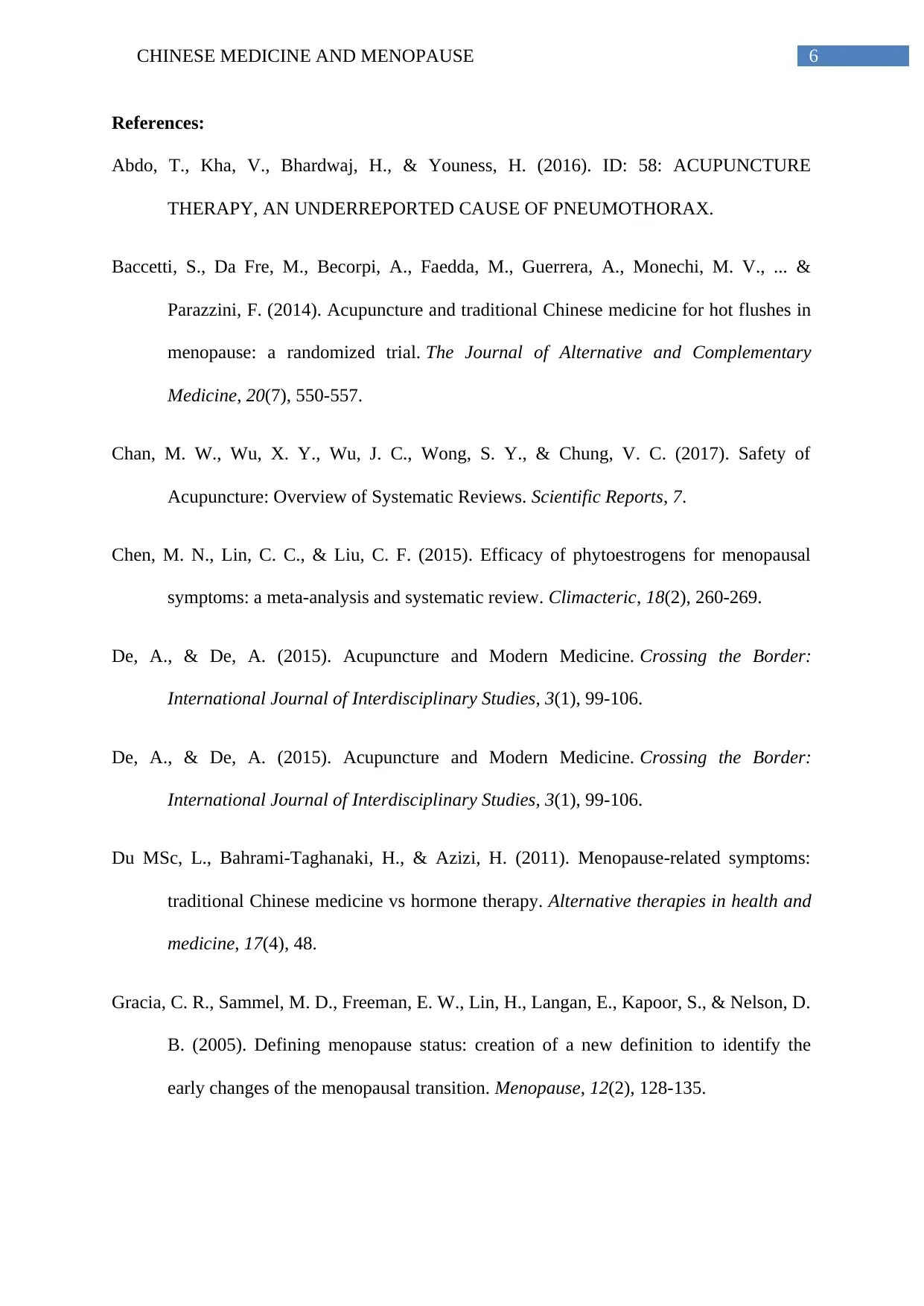
6CHINESE MEDICINE AND MENOPAUSE
References:
Abdo, T., Kha, V., Bhardwaj, H., & Youness, H. (2016). ID: 58: ACUPUNCTURE
THERAPY, AN UNDERREPORTED CAUSE OF PNEUMOTHORAX.
Baccetti, S., Da Fre, M., Becorpi, A., Faedda, M., Guerrera, A., Monechi, M. V., ... &
Parazzini, F. (2014). Acupuncture and traditional Chinese medicine for hot flushes in
menopause: a randomized trial. The Journal of Alternative and Complementary
Medicine, 20(7), 550-557.
Chan, M. W., Wu, X. Y., Wu, J. C., Wong, S. Y., & Chung, V. C. (2017). Safety of
Acupuncture: Overview of Systematic Reviews. Scientific Reports, 7.
Chen, M. N., Lin, C. C., & Liu, C. F. (2015). Efficacy of phytoestrogens for menopausal
symptoms: a meta-analysis and systematic review. Climacteric, 18(2), 260-269.
De, A., & De, A. (2015). Acupuncture and Modern Medicine. Crossing the Border:
International Journal of Interdisciplinary Studies, 3(1), 99-106.
De, A., & De, A. (2015). Acupuncture and Modern Medicine. Crossing the Border:
International Journal of Interdisciplinary Studies, 3(1), 99-106.
Du MSc, L., Bahrami-Taghanaki, H., & Azizi, H. (2011). Menopause-related symptoms:
traditional Chinese medicine vs hormone therapy. Alternative therapies in health and
medicine, 17(4), 48.
Gracia, C. R., Sammel, M. D., Freeman, E. W., Lin, H., Langan, E., Kapoor, S., & Nelson, D.
B. (2005). Defining menopause status: creation of a new definition to identify the
early changes of the menopausal transition. Menopause, 12(2), 128-135.
References:
Abdo, T., Kha, V., Bhardwaj, H., & Youness, H. (2016). ID: 58: ACUPUNCTURE
THERAPY, AN UNDERREPORTED CAUSE OF PNEUMOTHORAX.
Baccetti, S., Da Fre, M., Becorpi, A., Faedda, M., Guerrera, A., Monechi, M. V., ... &
Parazzini, F. (2014). Acupuncture and traditional Chinese medicine for hot flushes in
menopause: a randomized trial. The Journal of Alternative and Complementary
Medicine, 20(7), 550-557.
Chan, M. W., Wu, X. Y., Wu, J. C., Wong, S. Y., & Chung, V. C. (2017). Safety of
Acupuncture: Overview of Systematic Reviews. Scientific Reports, 7.
Chen, M. N., Lin, C. C., & Liu, C. F. (2015). Efficacy of phytoestrogens for menopausal
symptoms: a meta-analysis and systematic review. Climacteric, 18(2), 260-269.
De, A., & De, A. (2015). Acupuncture and Modern Medicine. Crossing the Border:
International Journal of Interdisciplinary Studies, 3(1), 99-106.
De, A., & De, A. (2015). Acupuncture and Modern Medicine. Crossing the Border:
International Journal of Interdisciplinary Studies, 3(1), 99-106.
Du MSc, L., Bahrami-Taghanaki, H., & Azizi, H. (2011). Menopause-related symptoms:
traditional Chinese medicine vs hormone therapy. Alternative therapies in health and
medicine, 17(4), 48.
Gracia, C. R., Sammel, M. D., Freeman, E. W., Lin, H., Langan, E., Kapoor, S., & Nelson, D.
B. (2005). Defining menopause status: creation of a new definition to identify the
early changes of the menopausal transition. Menopause, 12(2), 128-135.
Paraphrase This Document
Need a fresh take? Get an instant paraphrase of this document with our AI Paraphraser
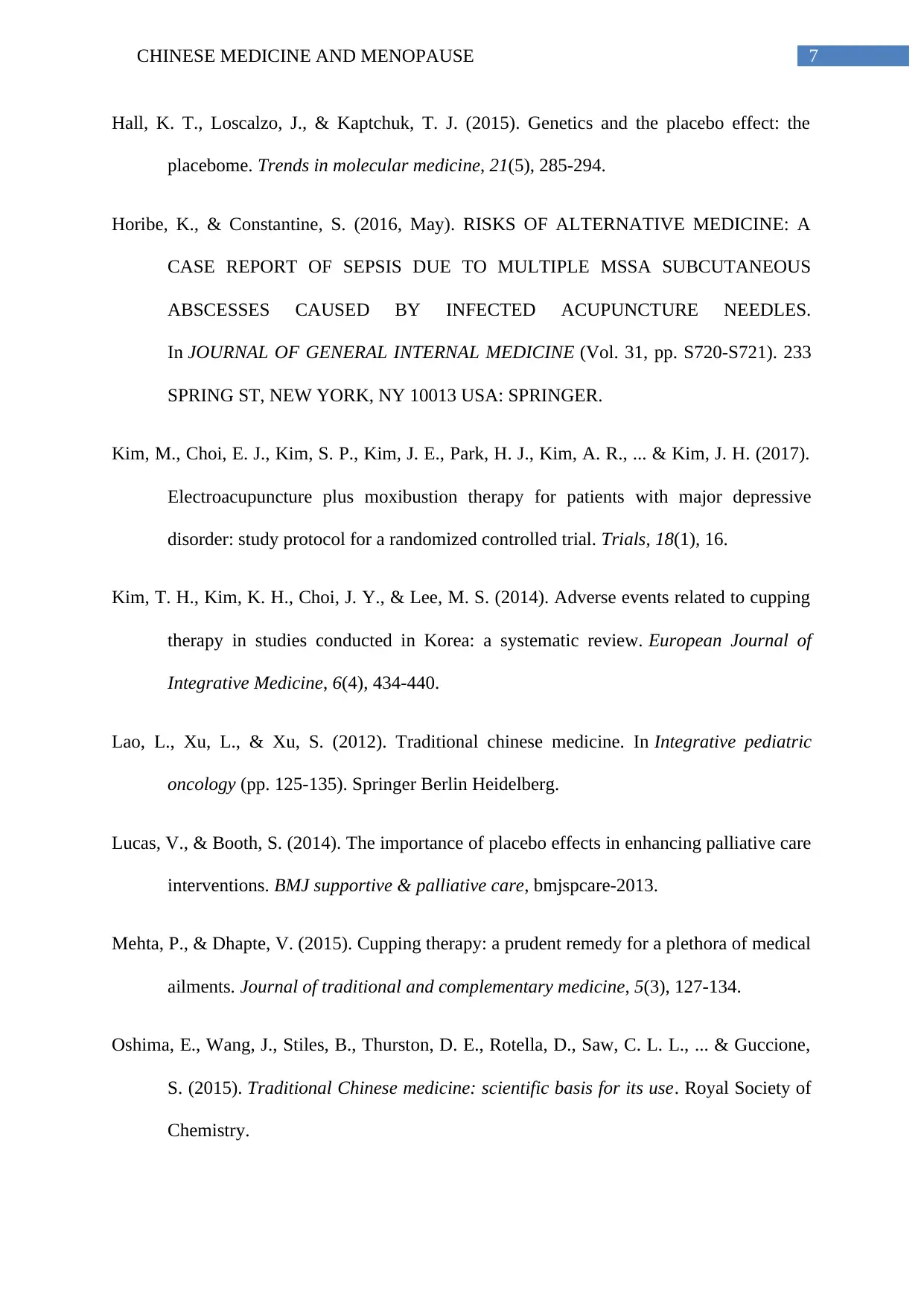
7CHINESE MEDICINE AND MENOPAUSE
Hall, K. T., Loscalzo, J., & Kaptchuk, T. J. (2015). Genetics and the placebo effect: the
placebome. Trends in molecular medicine, 21(5), 285-294.
Horibe, K., & Constantine, S. (2016, May). RISKS OF ALTERNATIVE MEDICINE: A
CASE REPORT OF SEPSIS DUE TO MULTIPLE MSSA SUBCUTANEOUS
ABSCESSES CAUSED BY INFECTED ACUPUNCTURE NEEDLES.
In JOURNAL OF GENERAL INTERNAL MEDICINE (Vol. 31, pp. S720-S721). 233
SPRING ST, NEW YORK, NY 10013 USA: SPRINGER.
Kim, M., Choi, E. J., Kim, S. P., Kim, J. E., Park, H. J., Kim, A. R., ... & Kim, J. H. (2017).
Electroacupuncture plus moxibustion therapy for patients with major depressive
disorder: study protocol for a randomized controlled trial. Trials, 18(1), 16.
Kim, T. H., Kim, K. H., Choi, J. Y., & Lee, M. S. (2014). Adverse events related to cupping
therapy in studies conducted in Korea: a systematic review. European Journal of
Integrative Medicine, 6(4), 434-440.
Lao, L., Xu, L., & Xu, S. (2012). Traditional chinese medicine. In Integrative pediatric
oncology (pp. 125-135). Springer Berlin Heidelberg.
Lucas, V., & Booth, S. (2014). The importance of placebo effects in enhancing palliative care
interventions. BMJ supportive & palliative care, bmjspcare-2013.
Mehta, P., & Dhapte, V. (2015). Cupping therapy: a prudent remedy for a plethora of medical
ailments. Journal of traditional and complementary medicine, 5(3), 127-134.
Oshima, E., Wang, J., Stiles, B., Thurston, D. E., Rotella, D., Saw, C. L. L., ... & Guccione,
S. (2015). Traditional Chinese medicine: scientific basis for its use. Royal Society of
Chemistry.
Hall, K. T., Loscalzo, J., & Kaptchuk, T. J. (2015). Genetics and the placebo effect: the
placebome. Trends in molecular medicine, 21(5), 285-294.
Horibe, K., & Constantine, S. (2016, May). RISKS OF ALTERNATIVE MEDICINE: A
CASE REPORT OF SEPSIS DUE TO MULTIPLE MSSA SUBCUTANEOUS
ABSCESSES CAUSED BY INFECTED ACUPUNCTURE NEEDLES.
In JOURNAL OF GENERAL INTERNAL MEDICINE (Vol. 31, pp. S720-S721). 233
SPRING ST, NEW YORK, NY 10013 USA: SPRINGER.
Kim, M., Choi, E. J., Kim, S. P., Kim, J. E., Park, H. J., Kim, A. R., ... & Kim, J. H. (2017).
Electroacupuncture plus moxibustion therapy for patients with major depressive
disorder: study protocol for a randomized controlled trial. Trials, 18(1), 16.
Kim, T. H., Kim, K. H., Choi, J. Y., & Lee, M. S. (2014). Adverse events related to cupping
therapy in studies conducted in Korea: a systematic review. European Journal of
Integrative Medicine, 6(4), 434-440.
Lao, L., Xu, L., & Xu, S. (2012). Traditional chinese medicine. In Integrative pediatric
oncology (pp. 125-135). Springer Berlin Heidelberg.
Lucas, V., & Booth, S. (2014). The importance of placebo effects in enhancing palliative care
interventions. BMJ supportive & palliative care, bmjspcare-2013.
Mehta, P., & Dhapte, V. (2015). Cupping therapy: a prudent remedy for a plethora of medical
ailments. Journal of traditional and complementary medicine, 5(3), 127-134.
Oshima, E., Wang, J., Stiles, B., Thurston, D. E., Rotella, D., Saw, C. L. L., ... & Guccione,
S. (2015). Traditional Chinese medicine: scientific basis for its use. Royal Society of
Chemistry.
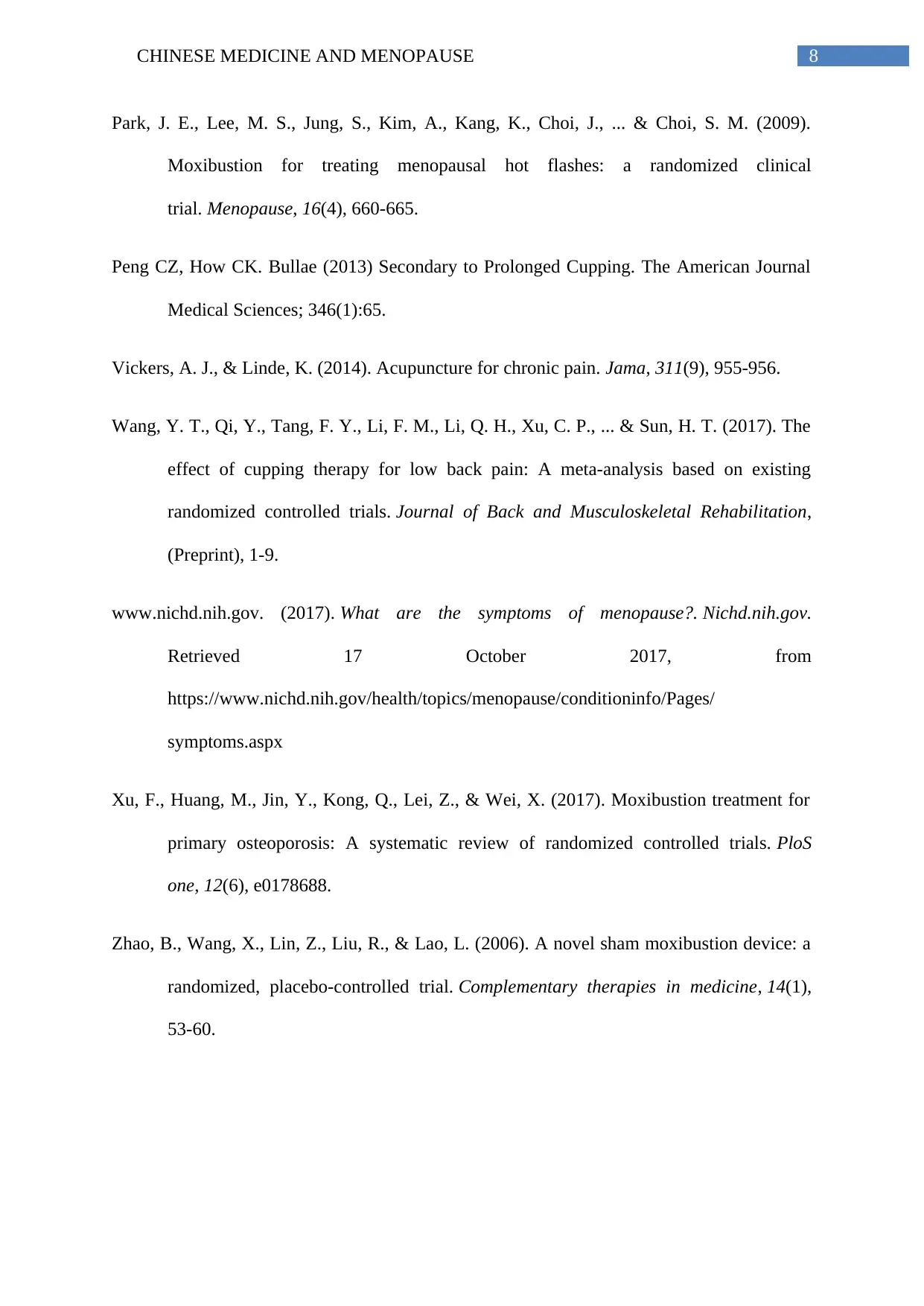
8CHINESE MEDICINE AND MENOPAUSE
Park, J. E., Lee, M. S., Jung, S., Kim, A., Kang, K., Choi, J., ... & Choi, S. M. (2009).
Moxibustion for treating menopausal hot flashes: a randomized clinical
trial. Menopause, 16(4), 660-665.
Peng CZ, How CK. Bullae (2013) Secondary to Prolonged Cupping. The American Journal
Medical Sciences; 346(1):65.
Vickers, A. J., & Linde, K. (2014). Acupuncture for chronic pain. Jama, 311(9), 955-956.
Wang, Y. T., Qi, Y., Tang, F. Y., Li, F. M., Li, Q. H., Xu, C. P., ... & Sun, H. T. (2017). The
effect of cupping therapy for low back pain: A meta-analysis based on existing
randomized controlled trials. Journal of Back and Musculoskeletal Rehabilitation,
(Preprint), 1-9.
www.nichd.nih.gov. (2017). What are the symptoms of menopause?. Nichd.nih.gov.
Retrieved 17 October 2017, from
https://www.nichd.nih.gov/health/topics/menopause/conditioninfo/Pages/
symptoms.aspx
Xu, F., Huang, M., Jin, Y., Kong, Q., Lei, Z., & Wei, X. (2017). Moxibustion treatment for
primary osteoporosis: A systematic review of randomized controlled trials. PloS
one, 12(6), e0178688.
Zhao, B., Wang, X., Lin, Z., Liu, R., & Lao, L. (2006). A novel sham moxibustion device: a
randomized, placebo-controlled trial. Complementary therapies in medicine, 14(1),
53-60.
Park, J. E., Lee, M. S., Jung, S., Kim, A., Kang, K., Choi, J., ... & Choi, S. M. (2009).
Moxibustion for treating menopausal hot flashes: a randomized clinical
trial. Menopause, 16(4), 660-665.
Peng CZ, How CK. Bullae (2013) Secondary to Prolonged Cupping. The American Journal
Medical Sciences; 346(1):65.
Vickers, A. J., & Linde, K. (2014). Acupuncture for chronic pain. Jama, 311(9), 955-956.
Wang, Y. T., Qi, Y., Tang, F. Y., Li, F. M., Li, Q. H., Xu, C. P., ... & Sun, H. T. (2017). The
effect of cupping therapy for low back pain: A meta-analysis based on existing
randomized controlled trials. Journal of Back and Musculoskeletal Rehabilitation,
(Preprint), 1-9.
www.nichd.nih.gov. (2017). What are the symptoms of menopause?. Nichd.nih.gov.
Retrieved 17 October 2017, from
https://www.nichd.nih.gov/health/topics/menopause/conditioninfo/Pages/
symptoms.aspx
Xu, F., Huang, M., Jin, Y., Kong, Q., Lei, Z., & Wei, X. (2017). Moxibustion treatment for
primary osteoporosis: A systematic review of randomized controlled trials. PloS
one, 12(6), e0178688.
Zhao, B., Wang, X., Lin, Z., Liu, R., & Lao, L. (2006). A novel sham moxibustion device: a
randomized, placebo-controlled trial. Complementary therapies in medicine, 14(1),
53-60.
⊘ This is a preview!⊘
Do you want full access?
Subscribe today to unlock all pages.

Trusted by 1+ million students worldwide
1 out of 9
Your All-in-One AI-Powered Toolkit for Academic Success.
+13062052269
info@desklib.com
Available 24*7 on WhatsApp / Email
![[object Object]](/_next/static/media/star-bottom.7253800d.svg)
Unlock your academic potential
Copyright © 2020–2025 A2Z Services. All Rights Reserved. Developed and managed by ZUCOL.
